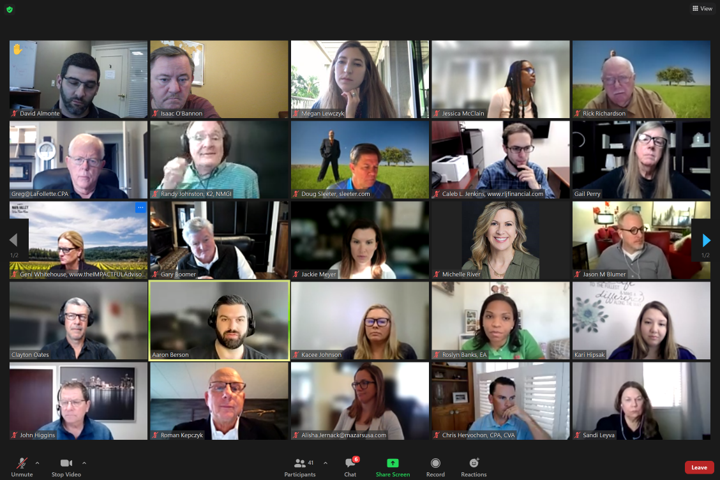By Steve Saah.
Succession planning is a crucial element in the strategic management of any organization, and CPA firms are no exception. As a business built on expertise, relationships and trust, your firm can face unique challenges when it comes to transitioning leadership — especially if you don’t have a plan and the employees you’d like to promote aren’t prepared to ascend.
Staff departures, including at the highest levels of a business, are inevitable. Yet, many companies push succession planning activities to the back burner, or don’t formalize the process. Some organizations have no plan at all. In a recent Robert Half survey, more than one-fifth of managers reported that their companies do not have a succession plan in place.
Prioritizing succession planning can help you improve your talent management while building a sustainable future for your CPA firm. It will help you make better hiring decisions when the time comes to replace critical personnel, and it will enable you to take a more proactive approach toward:
- Protecting client relationships: When you practice formal succession planning, you can gradually introduce up-and-coming leaders to your clients. This provides time for relationships to grow and trust to be transferred. It also reduces the risk of clients feeling uncertain or even deciding to take their business elsewhere after there is a change in the firm’s management.
- Preserving institutional knowledge: Your most experienced employees possess valuable knowledge, including an understanding of client histories and preferences, industry nuances, and complex regulatory landscapes. This knowledge is hard to replace, but with succession planning, you can ensure vital information and insights are passed along to emerging leaders.
- Retaining your best people: Succession planning demonstrates a commitment to the professional growth and development of your staff members across all generations and experience levels in your workforce. Employees are more likely to stay with an employer who invests in their future and provides a clear pathway for career progression.
Importantly, succession planning helps you identify which team members don’t want to take the helm one day, but would still like to lead in other ways — such as by managing teams or top accounts.The process can be a powerful tool for attracting top talent to your firm as well. High-performing professionals are often drawn to companies that exhibit stability and a clear vision for the future.
Now that we’ve examined some of the benefits of formal succession planning, let’s look at how to jump-start the process and make sure it’s successful.
Identify potential successors
This is not as simple as it sounds. You can’t just look at an organizational chart and assume that the next person in line for a crucial role is the right person to hire for it. Again, they may not even want that job. Robert Half’s research found that for 35% of employers, the lack of employees interested in leadership roles is a significant challenge in their succession planning efforts.
So, as a starting point, conduct a thorough assessment of internal talent to identify individuals with the potential — and desire — to assume leadership roles. This involves evaluating technical skills, leadership capabilities, and how the person navigates and contributes to your firm’s unique workplace culture.
While internal candidates are often preferred for succession, it is important to consider external talent who can bring fresh perspectives and new expertise to the firm.
Invest in targeted development and training
If you take the time to identify successors, then you will want to ensure those employees are ready to step up to leadership positions when tapped. It might be years before that happens, so you will need to create development and training programs that can keep those staff members engaged and help them to continuously build relevant skills and knowledge.
Mentoring, job shadowing and job rotation opportunities are ways to help future leaders build confidence and knowledge, while giving them both a broader and deeper view of your business. They are also cost-effective options for your firm to set up and manage.
Also, consider what types of skill sets your future leaders might need to help your CPA firm stay competitive and adapt to changes in the overall business landscape. For example, could these employees benefit from expanding their understanding of specific compliance topics, increasing their knowledge about a specific industry, or building up their generative AI skills?
Regularly review and adapt your plans
A common mistake employers make with succession planning is to “set and forget” their plans. But like any business continuity plan, succession plans need to be treated like living documents. The decisions you make today about who is best to lead your firm in the future may not be relevant a year from now. That’s especially the case if identified successors decide to move on from your firm.
It is good practice to regularly review and update succession plans to reflect the dynamics of your internal talent pool, as well as changes in market conditions and your firm’s strategic direction. Your succession plan should be flexible enough to adapt to unforeseen circumstances, such as the sudden departure of a key leader or changes in client needs.
Make it official — and secure stakeholder buy-in
You’ll also want to document your plan in writing to ensure clarity and accountability. Outline the processes, timelines and responsibilities involved. And be sure to address any legal considerations, such as partnership agreements, nondisclosure agreements and noncompete clauses, to avoid potential disputes during transitions.
Finally, make sure that your firm’s leadership team is fully committed to the succession planning process. This includes allocating the necessary resources and prioritizing succession planning as a strategic initiative. Be sure to involve key stakeholders in the planning process, such as partners, senior managers and human resources professionals, to gain diverse perspectives and buy-in.
Your employees aren’t fixed assets — and changes in your workforce lineup at all levels of the organization are inevitable. You may not always be able to predict a valued employee’s departure from the firm. But through effective succession planning, you can pave the way for business continuity and set a course for your firm’s future.
====
Steve Saah is the executive director of the finance and accounting permanent placement practice at Robert Half, the world’s first and largest specialized financial talent solutions service. The company has more than 300 locations worldwide. He is responsible for leading U.S. operations, based in the Washington, D.C., metropolitan area. He was named executive director in 2017, previously serving as director of permanent placement services.
Saah has been with the company since 1998, where he started as a recruiting manager, following a career as an internal auditor and assistant controller. He is a noted expert, author and presenter on career, management and hiring trends, particularly those affecting the accounting and finance fields. Saah earned a finance degree from Virginia Tech.
Thanks for reading CPA Practice Advisor!
Subscribe Already registered? Log In
Need more information? Read the FAQs




